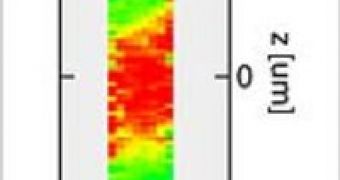Scientists have created a device that can map magnetic fields more accurately than ever, using an ultra-cold gas confined to a laser beam. It's based on ultra-cold Bose Einstein condensates (BECs) and can precisely measure low-frequency fields, like brain waves at an incredibly high resolution and sensitivity.
Dan Stamper-Kurn, UC Berkeley associate professor of physics and faculty scientist at Lawrence Berkeley National Laboratory, with postdoctoral researcher Mukund Vengalattore and former graduate student, now post-doc, James M. Higbie, said about the new device: "This is not a bulk sensor for magnetic fields, but a precision magnetometer that can measure the magnetic field over small length scales, on the order of microns - a thousand times smaller than a millimeter - with a field sensitivity which is comparable to or better than modern scanning-SQUID microscopes."
What they did was to cool a gas of rubidium atoms (rubidium-87) to a temperature of only 50 nanoKelvin, which is 50 billionths of a degree above absolute zero. Using the ultra-cool gas, they created a spinor Bose-Einstein condensate, a quantum fluid that manifests both frictionless flow, making it a superfluid and also magnetization, as a ferromagnet.
The result was the ability to detect a magnetic field measuring only 1 picoTesla, 50 million times weaker than the Earth's magnetic field of 50 microTesla. Another important advantage is the fact that this magnetic microscope is capable of mapping magnetic fields with an area of only 10 microns by 10 micron, a millionth the area of a postage stamp.
"With the BEC's strengths - its stability, its long coherence times, the fact that collisions don't shift the precession frequency - we have all the ingredients we need for a high spatial resolution magnetometer," said Vengalattore.
"The fact that we can take a single picture showing how all the atomic 'compass needles' have been rotated by the local magnetic field is ideal for getting the precise information we need at once, without having to scan slowly over a surface," added Higbie.
"This finally delivers on the promise of using Bose-Einstein condensed atoms for precision measurement," said Stamper-Kurn.
He and his colleagues are hoping the device could be used to study cavity quantum electrodynamics and possible applications in quantum computers.

 14 DAY TRIAL //
14 DAY TRIAL //